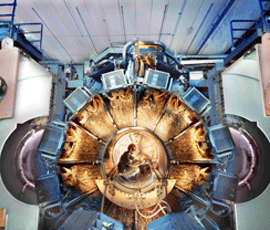BaBar data hint at cracks in the standard model
Recently analysed data from a particle accelerator in the US, known as BaBar, suggests possible flaws in the Standard Model of particle physics – the reigning description of the how the universe works.

Particle accelerator BaBar
The data from the physics experiment shows that a particular type of particle decay happens more often than the Standard Model suggests. Scientists at Queen Mary, University of London were part of a panel which reviewed the findings and presented them at a conference in China.
The particle accelerator, built by 10 countries including the UK and housed at the US Department of Energy revealed a particle called the B-bar meson decays into a D meson more often than the Standard Model of one in every 100 cases. While the difference is not enough to claim a break from the Standard Model, the results signal that something is potentially amiss and is likely to impact existing theories.
“This result is very interesting, and if confirmed could be a sign of physics beyond the standard model,” said Dr Adrian Bevan, Reader in Particle Physics at Queen Mary, University of London and UK spokesperson for BaBar.
Professor at the University of Victoria in Canada and BaBar spokesperson Michael Roney said: “The excess over the Standard Model prediction is exciting. The results are significantly more sensitive than previously published studies of these decays. But before we can claim an actual discovery, other experiments have to replicate it and rule out the possibility this isn’t just an unlikely statistical fluctuation”.
Fergus Wilson, one of the analysers of data from Babar who is from STFC’s Rutherford Appleton Laboratory, added: “Our current theory about the fundamental forces of the Universe, which has been around for nearly 40 years, is beginning to show signs of failure. Just as exciting, our new measurement indicates that any replacement theory will need to be more exotic and complex than we could have hoped or imagined. Although we must not jump to conclusions based on just one measurement, this new result is one of the most compelling yet. It follows on from previous indications recently reported by us, all of which point in the same direction.”
The BaBar experiment, which collected data from 1999 to 2008, was designed to explore various mysteries of particle physics, including why the universe contains matter, but no antimatter. Data from the collaboration which includes 75 institutions from the UK, Canada, France, Germany Italy, Norway, Russia, Spain, and the US helped confirm a matter-antimatter theory for which two researchers won the 2008 Nobel Prize in Physics. At its peak, some 90 British particle physicists and engineers from eleven institutions took part in the experiment.
Researchers continue to apply BaBar data to a variety of questions in particle physics.
Dr Bevan said: “This result will help guide teams of researchers looking for potentially related new physics effects at the Large HadronCollider and at other particle physics labs around the world.”
“If the excess decays shown are confirmed, it will be exciting to figure out what is causing it," said BaBar physics coordinator Abner Soffer, associate professor at Tel Aviv University. “Other theories involving new physics are waiting in the wings, but the BaBar results already rule out one important model called the Two Higgs Doublet Model. We hope our results will stimulate theoretical discussion about just what the data are telling us about new physics.”
The researchers also hope their colleagues in the Belle collaboration, which studies the same types of particle collisions, see something similar. Professor Rooney said: "If they do, the combined significance could be compelling enough to suggest how we can finally move beyond the Standard Model.”
The results have been presented at the 10th annual Flavour Physics and Charge-Parity Violation Conference in Hefei, China, and submitted for publication in the journal Physical Review Letters.
Related items

4 August 2025
For media information, contact:

